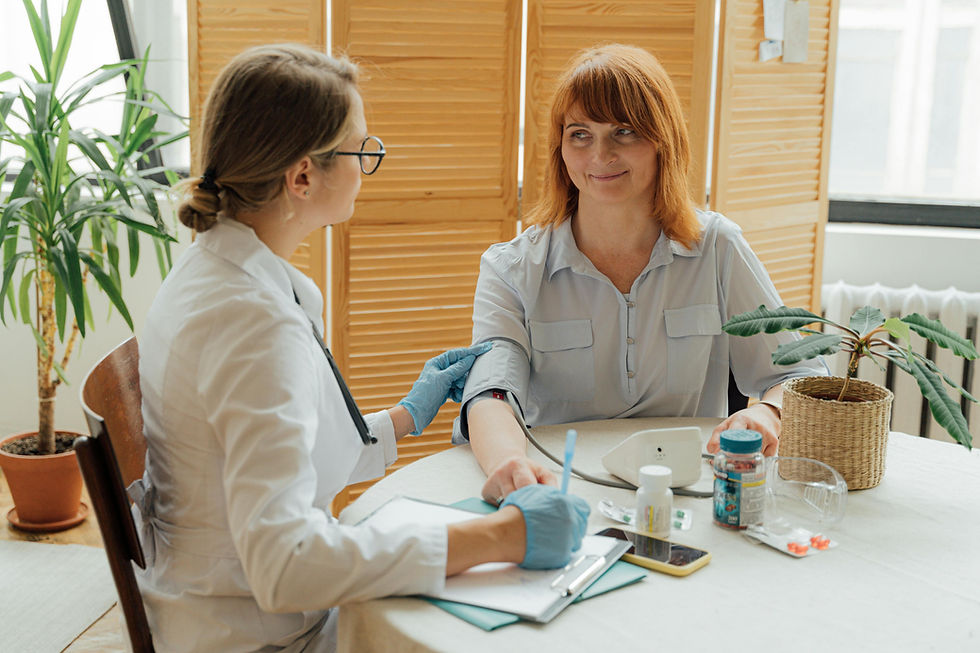NHS Alert: Why Pharmacists Should Review Warfarin and Tramadol Prescriptions Now
- Mohammed A Rashad

- Sep 17
- 4 min read

Every prescription tells a story, but sometimes the most critical chapters are hidden in the fine print. For pharmacists, the intersection of warfarin and tramadol is one of those moments where vigilance can make all the difference. Recent NHS alerts have brought this drug combination into sharp focus, urging pharmacy teams to act before a routine script becomes a patient safety crisis.
With anticoagulant-related hospital admissions on the rise, the stakes have never been higher. The Medicines Management Team is calling on all pharmacists to take a closer look at their prescribing records. Spotting patients on both warfarin and tramadol is not just a box-ticking exercise. It’s a proactive step that could prevent life-threatening complications and reinforce your role as a guardian of safe, effective care.
Key Takeaways:
What is Warfarin?
Warfarin is a widely prescribed oral anticoagulant, essential for preventing blood clots in patients with conditions such as atrial fibrillation, deep vein thrombosis, and mechanical heart valves. Its effectiveness relies on maintaining a delicate balance—too little and the risk of clotting rises, too much and the danger of bleeding becomes significant. Warfarin’s narrow therapeutic index means that even minor changes in a patient’s medication regimen or health status can have major consequences.
The Role of Tramadol
Tramadol is a commonly used opioid analgesic, valued for its effectiveness in managing moderate to moderately severe pain. It is often prescribed for chronic pain conditions, post-operative recovery, and musculoskeletal disorders. Tramadol’s popularity stems from its perceived lower risk of dependency compared to stronger opioids, but it is not without its own set of risks, especially when combined with other medications.
The Hidden Risk: Warfarin and Tramadol Interaction
Why Is This Combination a Concern?
When warfarin and tramadol are prescribed together, the risk of adverse effects increases significantly. The primary concern is that tramadol can enhance the anticoagulant effect of warfarin, leading to elevated INR (International Normalised Ratio) levels and a heightened risk of serious bleeding events. This interaction is not always immediately obvious, making it a silent threat in everyday pharmacy practice.
How Does the Interaction Occur?
Metabolic Pathways: Tramadol is metabolised in the liver, primarily via the CYP2D6 and CYP3A4 enzymes. Warfarin is also metabolised by liver enzymes, and any interference can alter its effectiveness.
Increased INR: Tramadol may inhibit the metabolism of warfarin, causing INR levels to rise unpredictably.
Bleeding Risk: Elevated INR increases the likelihood of spontaneous bleeding, which can be life-threatening if not detected early.
Real-World Impact
Recent NHS data and Medicines and Healthcare products Regulatory Agency (MHRA) reports have highlighted cases where patients on both medications experienced severe bleeding, some requiring hospital admission. These incidents underscore the importance of proactive medication reviews and patient monitoring.
NHS England Alert: Key Points for Pharmacists
What Does the NHS Alert Say?
The NHS England alert is clear: pharmacists must identify and review all patients currently prescribed both warfarin and tramadol. This is not just a recommendation—it is a call to action to prevent avoidable harm.
Key Recommendations:
Run a Search: Use your practice’s prescribing system to identify patients on both medications.
Review Each Case: Assess the clinical need for both drugs and consider alternatives where appropriate.
Monitor Closely: Ensure INR is checked more frequently if both drugs must be continued.
Communicate: Liaise with prescribers and patients to ensure everyone is aware of the risks and management plan.
Why Is This Important Now?
With the increasing complexity of patient medication regimens, the risk of drug interactions is higher than ever. The NHS alert aims to reduce preventable harm and support pharmacists in their vital role as medicines safety guardians.
Practical Steps for Pharmacists
How to Identify At-Risk Patients
Efficiently identifying patients at risk is the first step in preventing harm. Here’s how you can do it:
1. Run a Targeted Search
Use your pharmacy or GP practice software to filter patients prescribed both warfarin and tramadol.
Set up regular automated searches to catch new cases as they arise.
2. Review Patient Records
Check the indication for both medications.
Assess the duration of co-prescribing and any recent changes in dose or frequency.
Look for recent INR results and any history of bleeding or bruising.
3. Consult with the Prescribing Team
Discuss the necessity of both medications with the prescriber.
Consider alternative pain management options if appropriate.
Agree on a monitoring plan for INR and patient symptoms.
What To Do If You Identify a Patient
Once a patient is identified, take the following steps:
Contact the patient to discuss the potential risks and the importance of monitoring.
Arrange for an urgent INR check if not done recently.
Provide clear advice on signs of bleeding, such as unusual bruising, blood in urine or stools, or prolonged bleeding from cuts.
Document all actions in the patient’s record, including advice given and any changes made.
Patient Counselling Points
Effective patient education is crucial. When speaking to patients, ensure you:
Explain why extra monitoring is needed.
Advise on what symptoms to watch for and when to seek medical help.
Encourage them to inform all healthcare providers about their medication regimen.
Case Example: Proactive Intervention in Action
A 68-year-old patient with atrial fibrillation and chronic back pain was identified as taking both warfarin and tramadol during a routine medicines optimisation review. The pharmacist noticed a recent increase in bruising and arranged for an urgent INR test, which revealed a dangerously high level.
After consulting with the GP, tramadol was switched to an alternative painkiller, and the patient’s INR stabilised. This intervention likely prevented a serious bleeding event and reinforced the value of regular medication reviews.
Conclusion
The interaction between warfarin and tramadol is a clear example of how proactive pharmacy practice can save lives. By running targeted searches, reviewing patient records, and working closely with prescribers and patients, pharmacists can prevent serious harm and demonstrate the true value of medicines management.
Do not wait for an incident to occur. Take action now—review your patient lists, educate your team, and reach out to TMMT for support. Together, we can make medication safety a reality for every patient.
For further guidance or support, contact The Medicines Management Team today. Your vigilance could be the difference between harm and healing.




Comments